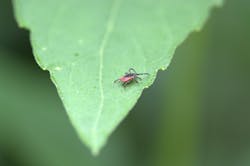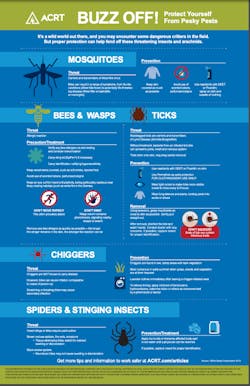Safety Spotlight: Protecting Yourself from Pesky Pests
With the arrival of spring and warmer weather, we should be considering a different risk. Utility vegetation management takes place almost exclusively in environments that are suitable habitats for numerous insects, which transmit serious diseases. Ticks and mosquitoes thrive in humid tree lines, tall grass, brushy areas and around open, standing water--which could describe many rights of way. Learning the different hazardous insect species in your region is an important preparation to avoid a potentially painful incident.
Ticks are widespread across the country, with 16 regionally specific tick-borne diseases including Lyme, Powassan and Rocky Mountain Spotted Fever. Once the daytime temperature gets above freezing, ticks are actively questing. Peak tick activity can be expected from March to mid-May and mid-August to November.
We focus a lot on Lyme disease, which is only caused by the Black Legged Deer Tick Ixodes scapularis. Female adult deer ticks and nymphs are the only stages that feed on humans and their combined life cycles can mean year-round risk.
If you are bitten, remove the tick using tweezers or a tick spoon. Prompt removal of ticks can prevent transmission of tick-borne pathogens. Next, try to identify the tick species, clean the area, and for 30 days, monitor yourself for symptoms including rash, fever, fatigue and joint pain. If you develop symptoms, tell your doctor about the tick bite, and when and where it occurred. A small number of diseases can develop shortly after the bite. Deer tick nymphs must be embedded for 36 hours to transmit the Lyme disease bacteria and even longer to transmit Babesia parasites. The CDC strongly discourages using results from lab tests to determine the need for antibiotics and does not recommend taking these medications after bites to prevent tick-borne diseases.
Frequent body checks throughout the day and after work are critical to find any ticks that may have slipped through your defenses. Check the hairline, waistline, legs and arms. When you shower at home, using a mirror to check hard to see areas is helpful. Using the high heat setting to dry work clothes will kill any remaining ticks.
At least 10 mosquito-borne diseases are identified in the United States. The most common is West Nile Virus, however, Zika Virus and Eastern Equine Encephalitis are on the rise. Mosquitos need open, standing water to complete the larvae cycle. In many areas there is almost a year-round threat, they are most active at dusk and dawn.
Wasps, hornets and yellowjackets differ from bees by stinging multiple times and often in swarms. Colonies nest in ground cavities, tree hollows, eaves and overhangs and typically are not aggressive until disturbed. If you see yellowjackets take measures to avoid disturbing the colony. If you disturb a colony or are being stung, move away slowly avoiding swift movements and using both hands to protect your face and other sensitive areas. Avoidance and understanding of seasonal habits are the best means of protection. If you or someone on your team is allergic to these or bee stings and requires an Epi-Pen to avoid Anaphylaxis, make sure others are aware and know where to locate it.
Spiders, wasps, chiggers, and fire ants can also cause a significant amount of pain and potentially lifelong suffering. For those traveling, checking hotels for bedbugs is also advised. Brown Recluse and Black Widow spiders prefer dark, protected areas and are not a threat unless provoked. Spider bites can cause significant tissue and neurological damage and require rapid medical attention. In the southern tier states, fire ants have established large populations and are named from the pain after their bites, which can be numerous and cause severe reactions. Being able to identify and avoid their mounds and avoid disturbing them is key.
Understanding the risk of running into something that wants to bite, sting or feed on your blood is the first and most important step in prevention. Knowing this, we can consider the hierarchy of controls and use administrative tools and personal protective equipment to reduce the risk.
Minimizing the amount of exposed skin with long sleeves along with tucking pant cuffs in is an additional layer of protection against most insect threats. The recommended protection includes the combination of repellant (DEET or Picardin-based product) on exposed skin to keep insects away and pesticide to kill them on contact (Permethrin) on all outerwear including boots. Clothing pre-treated with Permethrin is available as well as services that will treat clothes. A University of Rhode Island study found that people wearing permethrin-treated boots are 73.6 times less likely to have a tick bite than those wearing untreated footwear. With Permethrin, it is important to follow the directions, apply in a ventilated area and allow the item to dry.
We can safely work in areas where insects and arachnids exist as long as the appropriate measures are put in place.
About the Author
Keith Pancake
Keith Pancake is a safety manager serving ACRT and Bermex. He has been involved in the UVM industry for over 10 years. He is an ISA Certified Arborist and Utility Specialist, an NSC certified Defensive Driving Instructor, and the 2018 Utility Arborist Association’s Silver Shield recipient.

